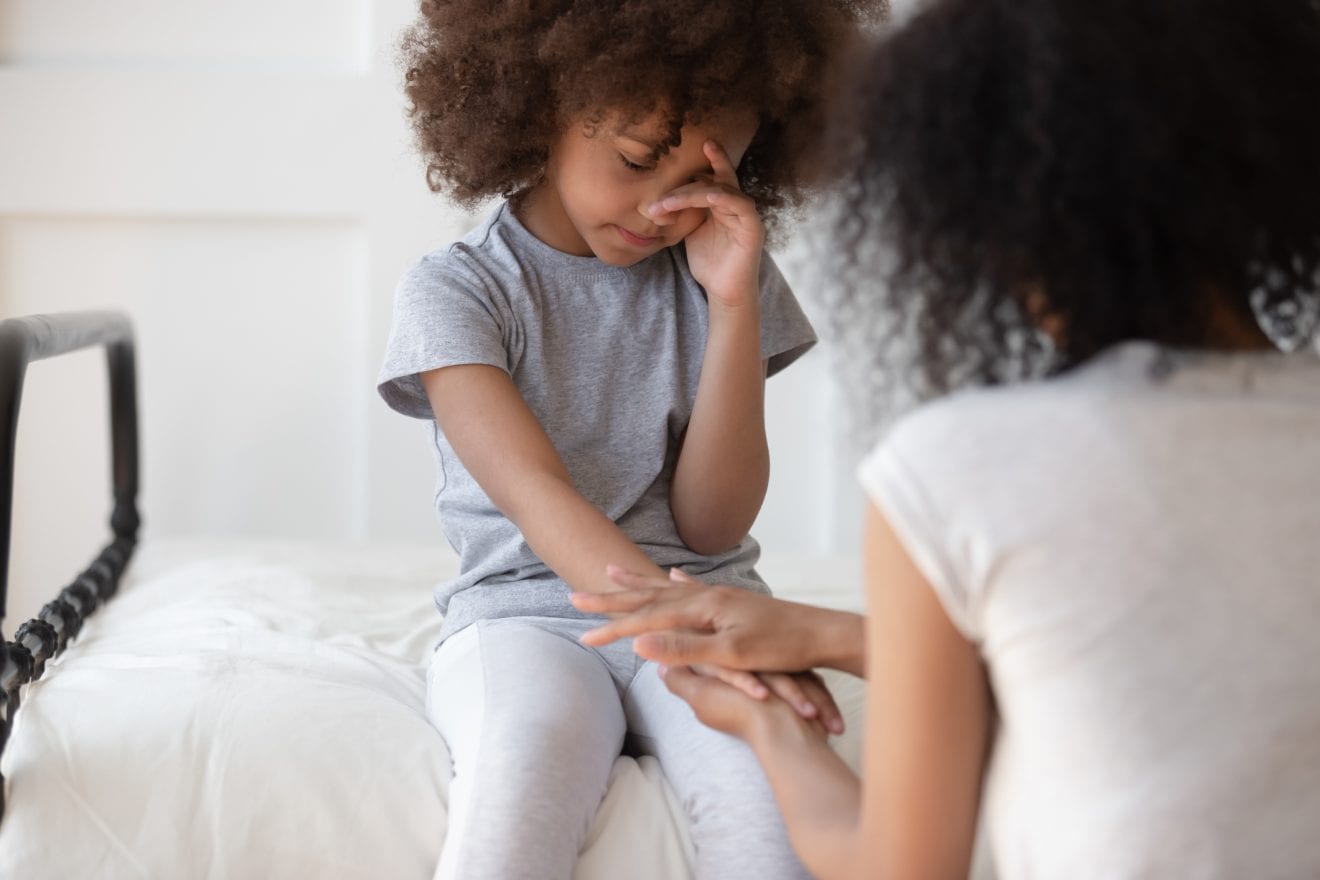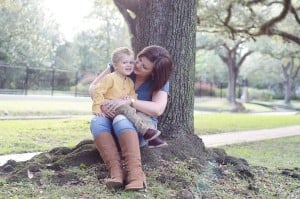Have you noticed that your child is complaining of stomach pain and headaches? Or perhaps they seem tired and irritable despite getting the correct amount of sleep? Maybe these things are coincidental, but maybe they’re not. Did you know that even children can suffer from an anxiety disorder? Many of the signs mentioned above can be normal things occurring during childhood (due to illness, developmental leaps, etc.), but they are also symptoms of anxiety, including worries or fears that seem excessive or disruptive to your child’s everyday life.1 If you have noticed any of these behaviors or sense that something else is going on with your child’s behavior, keep reading.
Our Personal Journey With Child Anxiety Disorder
My son was diagnosed with Generalized Anxiety Disorder at the age of 7. The combination of physical, emotional, and behavioral symptoms he displayed at home and school led us to seek a professional diagnosis and treatment plan. We used cognitive behavioral therapy methods to help him learn how his feelings would give him clues that his body was in severe “fight or flight” mode. We wanted him to know that he had the power to use coping strategies to make better decisions about how to tackle his anxiety.
While having coping strategies in place is necessary, it is not a quick fix. We have had to be committed to the plan and process by working with doctors and professional mental health practitioners to help my son learn lifelong skills. Some behavioral techniques we use daily in our home include modeling appropriate behaviors, role-playing, and implementing relaxation techniques such as meditation and prayer.
What We Decided Was Best for Our Son
Eventually, after much deliberation with medical professionals, we did use medication to treat some major symptoms he was experiencing during a family move. However, this was a short period, and we used medication in conjunction with psychotherapy and under a physician’s oversight.
Ultimately, we realized that the classroom and my son’s associated learning disabilities made going to school almost impossible. In the fourth grade, we decided that the home environment for learning would be best for him. So at age 10, we began homeschooling. This simple shift in his environment has created an opportunity for our son to thrive in both learning and overcoming his anxiety and disabilities.
Every family’s journey with pediatric anxiety disorders is different. Similarly, each family will have a unique treatment plan. The first step for any family, however, is learning more about anxiety disorders in children.
What Is an Anxiety Disorder?
The Anxiety Disorders Association of America characterizes an anxiety disorder as “a persistent, irrational, and overwhelming worry, fear, and anxiety that interfere with daily activities. These are real disorders that affect how the brain functions. Symptoms vary but can include irritability, sleeplessness, or physical symptoms such as headaches and stomachaches.”1
A combination of biological and environmental factors can cause anxiety disorders. Anxiety is normal, and at some point, all of us will experience periods of anxiety, potentially triggered by stressful events such as starting school, moving, or losing a parent or grandparent. However, stress itself does not cause an anxiety disorder. Anxiety could also be something a person has to tackle and address throughout their life (rather than an episode or temporary experience). To make a formal diagnosis, professionals will “check off” or look for specific symptoms to determine if your child might be experiencing anxiety.4
Types of Anxiety Disorders
Here is a list of some of the most common types of anxiety disorders and related symptoms or things to watch out for.4,5 It’s important to note that not all symptoms need to be present for a professional to make a diagnosis, and many of these symptoms can be normal or in response to other things occurring in a child’s life — so try not to become overwhelmed if you notice or identify any of these symptoms. Ensure that you engage a mental health professional (pediatrician, psychologist, etc.) who can formally diagnose an anxiety disorder if you are concerned.
Generalized Anxiety Disorder (GAD)
Excessive worry and fear can significantly impact areas of functioning and quality of life. Here are some common symptoms of Generalized Anxiety Disorder:4,5
- Excessive worries occurring more days of the week than not for a period of at least six months
- Difficulty controlling worry
- Being restless, keyed up, or on edge
- Feeling tired or becoming easily fatigued
- Irritability
- Difficulty concentrating
- Muscle tension
- Sleep disturbance or change in sleep patterns
It’s important to note that children, due to the ongoing development of language skills, may not be able to describe their worries adequately and are more likely to report physical symptoms (which include things like headaches and sore tummies) or want to avoid situations that bring up worries, fears, or distress.4,5
A child with GAD might “over worry” about various issues, including (but not limited to) worrying about:4,5
- Recess
- Lunchtime
- Birthday parties
- Playtime with friends
- Riding the school bus
- War or current events
- Weather
- Loved ones
- Safety
- Illness
- Getting hurt
Social Anxiety
Social anxiety may sometimes be referred to as social phobia. It is described as an intense fear of social and performance situations and activities, including being exposed to scrutiny by others. Think of a child who is terrified of getting on stage in front of many people during a play or skit. This disorder can lead to poor school performance and attendance and affect their ability to socialize with peers and develop and maintain relationships. It also includes:4,5
- The fear of showing anxiety and the subsequent worry about how others will react to this (negatively)
- Social situations that elicit fear, anxiety, and worries
- The avoidance of social situations
- When the fear is out of proportion to the situation, but the person isn’t aware of or doesn’t recognize this
As with GAD, the symptoms of social anxiety must occur for a period of longer than six months.4,5
Separation Anxiety
Separation anxiety is commonly experienced between the ages of 18 months and 3 years old when it is normal to feel some anxiety if a parent leaves the room or goes out of sight. It is common for your child to cry when you initially leave them at daycare or preschool. Crying usually subsides after they become distracted or engaged in their new place. Professionals warn that if your child is slightly older and unable to leave you for a known friend or family member, or if it takes longer than expected to calm down after you leave compared to other children, the problem could be separation anxiety disorder. This can influence their functioning and daily life. Symptoms include:4,5
- Anxiety at separation that is not developmentally appropriate (i.e., after the standard or “typical” developmental stage or age we would expect to see separation anxiety)
- Distress when anticipating separation
- Worry about losing their primary attachment figure or worry that harm will come to them (due to illness, accident, death, etc.)
- Persistent fears about unexpected events that could result in separation (kidnapping, getting lost, etc.)
- Avoidance of going out to avoid being separated from their primary attachment figure
- Reluctance to be alone
- Refusal to sleep away from their primary attachment figure
- Persistent nightmares that have a theme of separation
- Physical symptoms such as headaches, tummy aches, etc.
- Fear and avoidance that occurs for at least four weeks in children
Specific Phobia
A phobia is the intense, irrational fear of a specific object, such as a dog, or a particular situation, like swimming. Fears are common in childhood and often go away. However, phobias are more than just a fear. A phobia is diagnosed if the fear persists for at least six months and interferes with a child’s daily routine, such as refusing to play outdoors for fear of encountering a dog. The response to the stimuli (i.e., the thing they are phobic of) is immediate and occurs nearly every time they are exposed to it. Children will avoid situations or things they fear. Or they endure them with anxious feelings, which may show up as crying, tantrums, clinging, avoidance, headaches, and stomachaches.4,5
What to Look For?
What ultimately led me to the doctor’s office was my mother’s instinct. I knew that something was not right and that my child was not trying to manipulate and be difficult just for the sake of doing so. I want parents to know that tapping into their instincts is key despite all the Google searching and experts discussing the topic.
Identifying an anxiety disorder can be difficult because the symptoms are often internal. Many children have trouble expressing anxiety as the source of their distress, so it is likely to show up in various ways, like the physical symptoms mentioned — difficulty sleeping, headaches, tummy aches, etc.
Sometimes the physical “fight or flight response” accompanying intense anxiety moments can show up both physically and emotionally. In my son, we saw these arise as early as two years of age. Of course, I had no way of knowing what we would be dealing with at that time.
Physical symptoms
The following are common physical symptoms of anxiety:5
- Rapid heart rate
- Quick breathing or difficulty catching one’s breath
- Muscle aches (especially stomach and headaches)
- Shaking, dizziness, and tingling
- Sweating
- Fatigue
Emotional symptoms
Here are some of the emotional symptoms of an anxiety disorder:5
- Ongoing worries about friends, school, or activities
- Worrying about things before they happen
- A need for everything to be “perfect”
- Constant thoughts and fears about safety (of self or others, such as parents and siblings)
- Reluctance or refusal to go to school
- “Clingy” behavior with parents
- Inability to concentrate
- Irritability and having trouble relaxing
- Trouble sleeping
How to Get Your Child Help?
In the case of childhood anxiety, your child is typically the first source of information when it comes to moving toward a diagnosis. It is important to pay particular attention and listen carefully to them when discussing fears and worries. It is also important to report your findings to health professionals, such as a psychologist or pediatrician, for guidance if you are concerned.
In the meantime, the Association of Pediatrics recommends asking yourself the following questions:1
- Is your child excessively worried or anxious about several situations or activities?
- Does anxiety lead to restlessness, fatigue, difficulty concentrating, irritability, muscle tension, and/or sleep disturbance?
- Has your child’s anxiety or outward symptoms significantly impaired their social, academic, or other functioning?
- Does the anxiety occur more days than not and continue for a significant duration? (Have your child’s anxiety symptoms lasted for at least six months? Do the bouts of anxiety occur at least three to five times per week and last for at least an hour?)
- Did your child experience developmental delays or severe anxiety at being separated from a parent, express frequent or numerous fears, or experience unusual stress?
- Have others in the family been diagnosed with anxiety disorders?
Anxiety disorders tend to run in families, but this is not always the case.2 A careful review of your family’s medical history may provide insight into your child’s condition. The presence of anxiety disorder symptoms may indicate a need to have a pediatrician or mental health provider evaluate your child.
What Are Some of the Common Treatments?
The key is recognizing the symptoms and seeking medical advice sooner. Treatment for an anxiety disorder relies on a combination of approaches geared specifically to the particular child and their unique diagnosis.3
My advice to parents is to become highly educated about the disorder so that you can find ways to help your child and create success at both home and school. The most common ways to treat an anxiety disorder include cognitive-behavioral techniques and traditional psychotherapy, family therapy, and medication management, which is less common but is also an approved treatment. There are many opinions about taking medication and using the non-medication approach. It is necessary to be very clear on these options and weigh them with a professional. Only you can decide what is best for your child and your family.
Behavior therapies tend to be among the most proven and effective non-medication treatments for anxiety disorders. They concentrate on creating awareness and changing the child’s anxious behaviors rather than focusing on the child’s internal conflicts (like bellyaches and headaches). When a child learns how to identify anxious feelings and thoughts, recognize how their body responds to anxiety (sometimes physical pain), and devise a plan to regulate the symptoms as they appear, they gain coping strategies that allow them to be confident in overcoming the symptoms of anxiety. This method is what worked best for my son. And we can communicate this to our support systems, such as family, babysitters, coaches, and teachers.
Hope for the Future
Although having my 7-year-old child diagnosed with an anxiety disorder was unexpected, I can look back and realize the signs were there. But I had no idea that his little body was struggling to process his emotions and fears. Today, my son is almost 11 years old and is well aware of the issues in dealing with anxiety. He can often rely on the coping strategies that he has learned to help him through difficult situations. He knows how to recognize his symptoms and ask for help when he needs it.
Here’s my advice: the sooner your child receives the proper treatment for anxiety, the sooner they can improve their functioning and balance in their daily life. When a child shows signs of anxiety, we tend to think that it will “go away” on its own or that the child will outgrow it. But when it is intense and interfering with a child’s life, it is essential to get help. My journey has led me to help others see the value in recognizing this disorder. And helping families understand that they can manage, cope, and have a positive outcome.
































